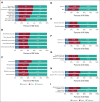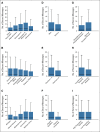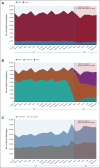Future of Teleoncology: Trends and Disparities in Telehealth and Secure Message Utilization in the COVID-19 Era
- PMID: 35467963
- PMCID: PMC9067360
- DOI: 10.1200/CCI.21.00160
Future of Teleoncology: Trends and Disparities in Telehealth and Secure Message Utilization in the COVID-19 Era
Abstract
Purpose: The COVID-19 pandemic created an imperative to re-examine the role of telehealth in oncology. We studied trends and disparities in utilization of telehealth (video and telephone visits) and secure messaging (SM; ie, e-mail via portal/app), before and during the pandemic.
Methods: Retrospective cohort study of hematology/oncology patient visits (telephone/video/office) and SM between January 1, 2019, and September 30, 2020, at Kaiser Permanente Northern California.
Results: Among 334,666 visits and 1,161,239 SM, monthly average office visits decreased from 10,562 prepandemic to 1,769 during pandemic, telephone visits increased from 5,114 to 8,663, and video visits increased from 40 to 4,666. Monthly average SM increased from 50,788 to 64,315 since the pandemic began. Video visits were a significantly higher fraction of all visits (P < .01) in (1) younger patients (Generation Z 48%, Millennials 46%; Generation X 40%; Baby Boomers 34.4%; Silent Generation 24.5%); (2) patients with commercial insurance (39%) compared with Medicaid (32.7%) or Medicare (28.1%); (3) English speakers (33.7%) compared with those requiring an interpreter (24.5%); (4) patients who are Asian (35%) and non-Hispanic White (33.7%) compared with Black (30.1%) and Hispanic White (27.5%); (5) married/domestic partner patients (35%) compared with single/divorced/widowed (29.9%); (6) Charlson comorbidity index ≤ 3 (36.2%) compared with > 3 (31.3%); and (7) males (34.6%) compared with females (32.3%). Similar statistically significant SM utilization patterns were also seen.
Conclusion: In the pandemic era, hematology/oncology telehealth and SM use rapidly increased in a manner that is feasible and sustained. Possible disparities existed in video visit and SM use by age, insurance plan, language, race, ethnicity, marital status, comorbidities, and sex.
Conflict of interest statement
Figures



References
-
- 2020 Trends in Cancer Care Delivery, Association of Community Cancer Centers,2021. https://www.accc-cancer.org/docs/documents/surveys/2020-trends/2020-tren...
-
- GovTrack : Coronavirus Preparedness and Response Supplemental Appropriations Act, 2020, HR 6074, 116th Congress, 2020. https://www.govtrack.us/congress/bills/116/hr6074
-
- Sternberg A: ASCO Submits Comments to Congress Supporting Advanced Measures to Facilitate Telehealth Access, 2021. https://www.cancernetwork.com/view/asco-submits-comments-to-congress-sup...
-
- Claxton G, Rae M, Cox C: Coverage and Utilization of Telemedicine Services by Enrollees in Large Employer Plans.Kaiser Family Foundation and The Peterson Center on Healthcare, 2020. https://www.healthsystemtracker.org/brief/coverage-and-utilization-of-te...
-
- Demeke HB, Merali S, Marks S, et al. : Trends in Use of Telehealth Among Health Centers During the COVID-19 Pandemic—United States, June 26–November 6, 2020, Centers for Disease Control and Prevention, 2021. https://www.cdc.gov/mmwr/volumes/70/wr/mm7007a3.htm - PMC - PubMed
Publication types
MeSH terms
LinkOut - more resources
Full Text Sources
Medical

